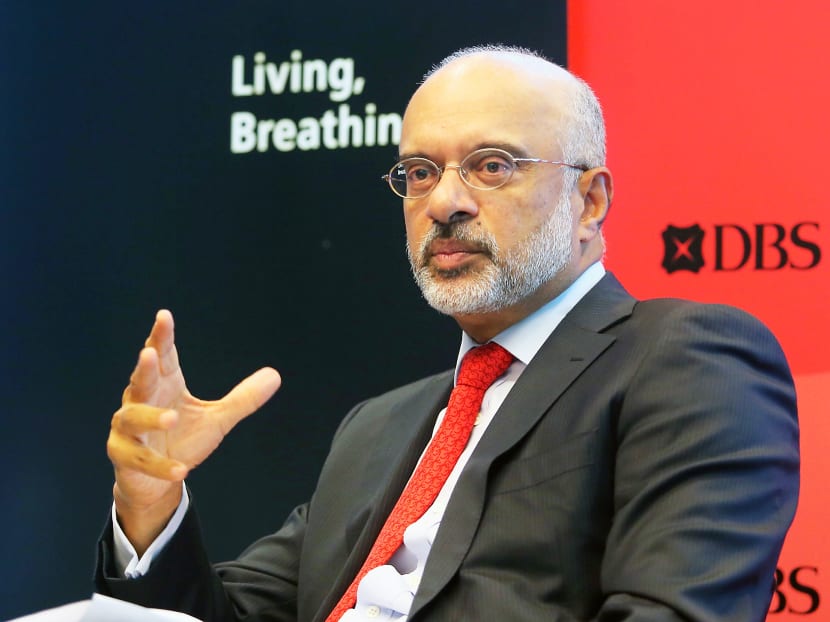Analysts rethink DBS earnings outlook after Swiber losses
SINGAPORE — DBS Group Holdings’s exposure to a troubled oil-services firm has analysts scrambling to revise their forecasts for the lender and the wider Singapore banking sector ahead of DBS’s quarterly earnings report on Monday (Aug 8).

DBS’ chief executive Piyush Gupta in 2015. Photo: Ernest Chua/TODAY
SINGAPORE — DBS Group Holdings’s exposure to a troubled oil-services firm has analysts scrambling to revise their forecasts for the lender and the wider Singapore banking sector ahead of DBS’s quarterly earnings report on Monday (Aug 8).
The changing outlook follows the bank’s July 28 filing that it expects to recover only half of its S$700 million exposure to Swiber Holdings and its units, for which it would set aside S$150 million.
Analysts started crunching the numbers immediately: The extra provisioning would be taken in the second quarter and cut 2016 earnings by 3 per cent, Goldman Sachs said in a July 29 report. JPMorgan Chase this week questioned DBS’s ability to handle nonperforming loans as it downgraded the lender’s stock. Moody’s Investors Service warned on Thursday that the funds Singaporean banks had set aside to cover souring energy exposures isn’t enough.
“The substantial upward revision to DBS’ provisioning for its Swiber exposure is an indication that the current deterioration in the oil and gas industries could have a far stronger bottom line impact on the banks than previously expected,” Moody’s said in a statement.
WEAK STATE
Swiber, which provides construction services for international oil and gas projects, filed a petition last week to liquidate its operations, after facing payment demands from creditors. The firm subsequently dropped the liquidation in favor of a plan to operate under judicial management, which would allow it to continue business under court supervision while it attempts to turn itself around.
“Our analysis of Swiber’s listed peers suggests that Swiber is representative of the weak financial state currently prevalent in the broad oil and gas industry,” Moody’s said. “Under these circumstances, we cannot rule out the risk of a broader default of a loss severity akin to Swiber.”
DBS and Singapore’s two other large banks, Oversea-Chinese Banking and United Overseas Bank, are exposed to the downturn in the energy sector as a result of their lending to local companies, which provide construction, shipping and maintenance services to the oil and gas industry. Many of those companies are suffering as the plunge in crude prices since 2014 curtailed exploration and other activity by oil and gas producers.
Under a “severe stress scenario”, DBS would be the worst hit among the three banks because it has the highest exposure to the oil and gas services sector, Moody’s said. Almost 60 per cent of its second half pre-provision income this year would be eroded by loan-loss provisions in that scenario, while OCBC and UOB would see losses of 40 per cent to 50 per cent, the ratings company said.
The financial health of the energy-services companies is the “key concern” for UOB over the next one or two years, chief executive Wee Ee Cheong said on July 28 after his bank’s results. The lender’s exposure to Swiber is “manageable”, Mr Wee said, though he noted that the wider difficulties in the oil and gas services industry were a factor behind the 17 per cent climb in UOB’s nonperforming assets for the second quarter.
UOB’s exposure to Swiber is more than US$35 million, the company’s fourth-largest creditor, the Business Times reported on Friday, citing a court document.
DBS’s capital adequacy ratio is unlikely to be impacted by Swiber’s debt, chief executive Piyush Gupta told CNBC in an interview on Thursday. The bank’s common equity Tier 1 ratio stood at 14 per cent as of March.
“We’ve built a lot of provisions and reserves ahead of time and as best as we can tell, therefore, it is unlikely it will have impact on our capital adequacy or on fundamental strengths of the DBS balance sheet,” Mr Gupta said.
Prior to the bank’s announcement on its Swiber exposure, analysts had expected it to report second-quarter net incomeof S$1.07 billion, a 4 per cent drop from a year earlier, according to the average of five estimates compiled by Bloomberg.
In an Aug 3 report, JPMorgan analysts Harsh Modi and Raunak Mukherjee cut their rating on DBS to neutral from overweight and recommended investors sell the bank’s stock before the results.
The JPMorgan analysts cut their forecasts for DBS’s earnings for this year through 2018 by 6 per cent. They lowered their share-price target to S$15 from S$16. The stock sank 0.3 per cent to S$15.04 on Thursday, taking its drop this year to 9.9 per cent. BLOOMBERG





